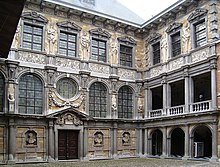Rubens House
The Rubens House ( ndl. Rubenshuis ) in Antwerp is the former home and workshop of Peter Paul Rubens (1577–1640). The building, erected around 1610, is now a museum about his life and work and is not far from the main train station.
Rubens and Antwerp
Rubens came from a well-known Antwerp family and spent almost his entire adult and artistically active life in what was then the metropolis, which is why he is regarded as the “great son of the city”. Peter Paul Rubens was born in 1577 in Siegen , then Nassau , where his parents were in exile.
His father Jan Rubens was a councilor and a respected patrician of Antwerp. Because of the religious persecution in the Spanish Netherlands , the Reformed family had to leave the city in 1568. After that, as the lawyer for Anna von Sachsen , the father came into conflict with her husband Wilhelm von Oranien and was detained in Siegen. The birth of the son apparently took place during this time. After the death of his father, Peter Paul moved back to their hometown with his mother at the age of 10.
Rubens lived in Antwerp until his death in 1640, only interrupted by a long trip to Italy from 1600 to 1608 and a few stays abroad in the diplomatic service.
In addition to his town house, which is now used as a museum, Rubens owned his country estate in Steen near Mechelen .
Rubens is considered the most important Antwerp citizen of all time. That was one reason for the city to acquire the Rubens House in 1937 and to erect a memorial in 1946.
Construction and use during Rubens' lifetime
After his marriage to Isabella Brant in 1610, Peter Paul Rubens had a house built in what was then Vaartstraat , now Wapper . He designed the plans for his palace himself, based on Italian Renaissance palazzi . It became an apartment and studio with a large entrance to the inner courtyard. The garden behind the house was also laid out in the Flemish- Italian Renaissance style.
Next to the house he set up a large workshop , from which approx. 2500 panel and canvas paintings by apprentices come from. Rubens headed this workshop production as a guarantee of quality. In the master workshop on the upper floor Rubens made his own drawings, portraits and small paintings, and from there he conducted correspondence both at home and abroad. The 5000 letters that have survived are written in Dutch, French, Latin and, above all, Italian.
Rubens lived in this house for most of his life. On May 30, 1640, the master died of gout here in his house . His magnificent grave, designed by his colleague and friend Johann Bockhorst , is located in the nearby Jakobikirche .
Re-use and conversion into a museum
After Rubens' death, Helena Fourment rented the apartment from 1648 to 1660 to William Cavendish and his wife , who had left their home because of the English Civil War . Upon Cavendish's return to England, the building was sold and divided by the heirs.
It was not until the 19th century that the city knew how to publicly honor its most famous citizen. In 1843, a statue by Willem Geefs in Rubens' honor was erected on the Groenplaats on the south side of the Liebfrauendom . Rubens' 300th birthday in 1877 was also celebrated in Antwerp. Only his former place of residence and work was still privately owned.
It was only after almost 300 years, in 1937, that the city of Antwerp bought the building. After a restoration, interrupted by the Second World War and the occupation of the city by Nazi Germany , the Rubens House was opened as a museum in 1946.
Some of his works can be found in the halls and rooms today. One of his earliest works can be viewed in the large studio: Adam and Eve in Paradise. In the old pantry hangs his most famous self-portrait, painted at the age of about fifty.
The Rubens House garden was upgraded in 1993 and 2001 in particular. These cautious measures, which had to be carried out without a reliable historical source, were recognized by the Council of Europe and led to membership in the European Garden Heritage Network .
The Rubenianum , a research center for the study of Rubens and Flemish art, is located in the Kolveniershof in the back garden of the Rubens House.
Web links
- The Rubenshuis museum on the city's website
- Rubenianum
Individual evidence
- ↑ Rubenshuis: Rijschool van Cavendish ( Memento of the original from December 22, 2015 in the Internet Archive ) Info: The archive link has been inserted automatically and has not yet been checked. Please check the original and archive link according to the instructions and then remove this notice. .
- ↑ Van Beneden, Ben; De Poorter, Nora (ea): Vorstelijke vluchtelingen: William en Margaret Cavendish in het Rubenshuis 1648-1660. Antwerp: Rubenshuis & Rubenianum: 2006. (Published on the occasion of the exhibition "Vorstelijke vluchtelingen: William en Margaret Cavendish in het Rubenshuis 1648-1660", October 1, 2006 - December 31, 2006.)
Coordinates: 51 ° 13 '2 " N , 4 ° 24' 34" O

